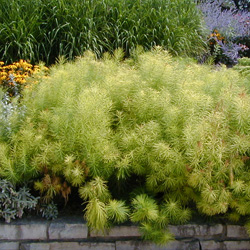
Amsonia hubrichtii was the Perennial Plant Association’s plant of the year 2011. This southern native was “discovered” in Arkansas in 1942 by an assistant to a botanist at the Missouri Botanical Garden – Mr. Leslie Hubricht, for whom it is named. It actually had been collected previously, but had been misidentified as A. ciliata var. filifolia. Commonly called Arkansas blue star or thread-leaf blue star, this member of the dogbane family (Apocynaceae) grows naturally in fields, dry, rocky outcrops and well-drained creek banks and bottomlands of Arkansas,
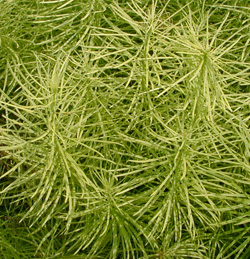
Oklahoma, and Missouri (mainly in the Ouachita Mountains of Arkansas and Oklahoma) and is hardy in zones 4-9.
Arkansas blue star is an herbaceous perennial that forms bushy clumps up to 3 feet tall and wide. The stems are densely covered with soft, narrow, needle-like leaves that create a ferny appearance. The willowy, medium to dark green leaves turn a brilliant golden yellow color in the fall.
Terminal clusters of steel blue buds and small, light blue flowers are produced in late spring and early summer.
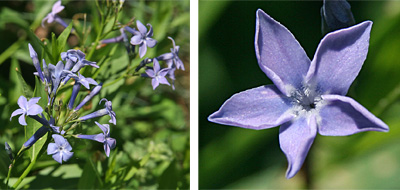
The 2-3” wide inflorescences are often obscured by the foliage. Each ½-inchstar-shaped blossom has 5 petals that fade to white when the weather warms. The flowers are followed by slender, rounded, elongated seed pods.
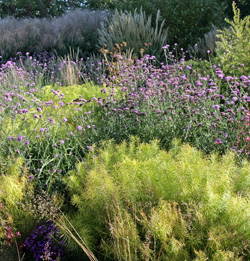
The finely textured A. hubrichtii combines well with many other perennials with coarser foliage, especially other natives such as blackeyed Susan (Rudbeckia sp.) and coneflowers (Echinacea purpurea, E. paradoxa, and Ratibida sp.). The mounded shape is a good contrast to more vertical plants such as Iris or upright prairie grasses such as Panicum ‘Heavy Metal’ or ’Dallas Blues’. It makes a perfect backdrop for lower growing annuals and perennials, and late summer and fall bloomers including asters, mums and tall sedums, especially when grown in masses. It’s spectacular fall color is one of its best features, which is even more impressive when combined with dark-leaved plants such as Sambucus ‘Black Lace’
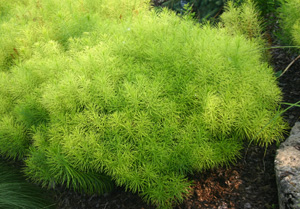
or one of the purple-foliaged sedums or heucheras. This plant is appropriate in both formal and informal settings, in mixed or perennial borders, and is especially nice in naturalistic settings such as wildflower gardens, large rock gardens, or open woodlands.
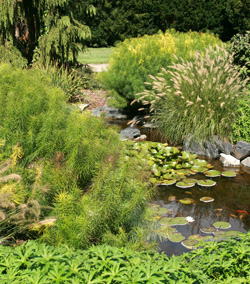
This low maintenance perennial does best in full sun, but will also grow in partial shade. It will be lanky and may flop over if grown in rich soil or too much shade, and fall color will not be as intense in shady conditions. It can be cut back after flowering to promote more compact growth, but does not require deadheading. (Be sure to wear gloves when pruning this plant as the milky white sap can cause irritation to sensitive skin.) It is not picky about soil type, thriving in everything from sand to clay, but does not like to remain wet. It may be slow to establish and may not look very impressive in the first year or two, but is long-lived and mostly pest free. It is not favored by deer or rabbits.
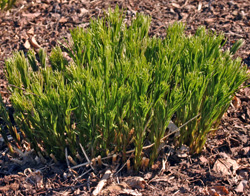
Because the clumps expand very slowly it usually does not require frequent division. It is best to wait until spring to cut the stems from the previous year’s growth back to the ground.
Arkansas blue star can be propagated from seed sown in the spring or fall (although germination tends to be somewhat erratic and slow), or from divisions in spring. Softwood cuttings, preferably from non-flowering stems, can also be taken in early summer and should root within 3-4 weeks.
– Susan Mahr, University of Wisconsin-Madison
Latest from Wisconsin Yard & Garden
Ask Your Gardening Question
If you’re unable to find the information you need, please submit your gardening question here:





 ▶︎ Watch: Fall Bulb Planting
▶︎ Watch: Fall Bulb Planting Aster, Symphyotrichum spp.
Aster, Symphyotrichum spp. Fascinating Fasciation
Fascinating Fasciation Alternatives to Lawn: Groundcovers
Alternatives to Lawn: Groundcovers


